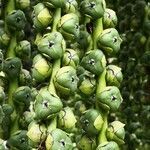Stems solitary, to 20 m tall, 40-60 cm in diam. Leaf petioles to 1.5 m; rachis to 5 m; pinnae to 150 per side of rachis, linear, with ears at bases, irregularly arranged and spreading in different planes; middle pinnae 120-160 cm, 5-9 cm wide at mid-point. Inflorescences to 2.5 m; male rachillae 40-50, to 40 cm; male flowers 12-15 mm; sepals ca. 5 mm; petals ca. 12 mm; stamens 60-120; female rachillae 40-50, ca. 30 cm; female flowers 10 mm; sepals ca. 2 mm; petals ca. 4 mm. Fruits greenish, yellowish, or orangish, globose to ovoid, to 7 × 6 cm.

